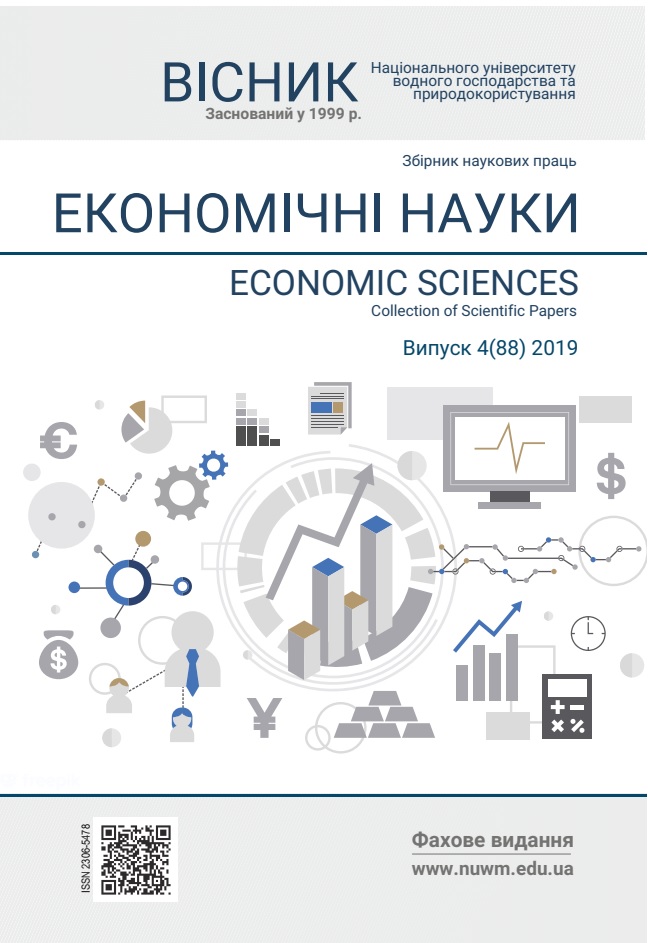IMPROVEMENT OF VALUE ADDED TAX ACCOUNTING IN AN INFORMATION SYSTEM
DOI:
https://doi.org/10.31713/ve4201927Keywords:
value added tax, tax calculations, accounting automation, accounting information system, information system mechanisms.Abstract
The article presents features of automation VAT calculations inthe accounting information system and recommendations for theirimplementation and applying by business entities. VAT calculations are one of the most time-consuming areas of the accounting process.The complexity of accounting for this tax is due to a number of factors.Only the correct using of all information systems capabilities,operative analysis and control of their data can provide the minimumrisk of errors in VAT calculations. There are a lot of program in thesoftware market for automation accounting. The most popular systemis «Accounting for Ukraine». Accounting of VAT calculations in thesystem «Accounting for Ukraine» is based on the next principles: todefine the taxation scheme in the enterprise’s accounting policy; to seta VAT rate for all transactions that include VAT; to define the taxstatus of the operation; to organize the accounting of tax credit and taxliabilities by stages; to organize the accounting with detail of the VATstatement items. The usage features of the main principles arepresented in the article, the recommendations for their practicalapplication are given. The accounts, which information system usesfor VAT calculations accounting are defined. The features of analyticalaccounting are described. The possibilities of operative control forcorrectness and completeness of accounting data are presented. Thespecial accumulation registers of VAT calculations accounting in thesystem «Accounting for Ukraine» are considered. The relationshipbetween VAT accounting mechanisms in the information system ispresented. Adherence to basic principles of VAT calculationautomation and taking document’s requisites into account in thesystem «Accounting for Ukraine» will provide full automation andcorrectness of tax calculations. This will shorten their execution timeand improve the reliability of tax statement information. The system«Management of a trading company» and «Management of productionenterprise» operate with similar principles of VAT calculationsautomation. So, our recommendation will be useful for theseprograms.References
Коваль С. В. Удосконалення обліку товарних операцій аграрних підприємств шляхом використання автоматизованих систем обробки інформації. Науковий вісник Ужгородського університету. Ужгород, 2018. Вип. 1(51). С. 425–429.
Осмятченко В. О., Токар В. В. Програмне забезпечення бухгалтерського обліку на засадах аутсорсингу. Економіка та держава. Київ, 2018. № 5. С. 17–21.
Очеретько Л. М. Особливості організації внутрішнього контролю розрахунків за ПДВ. Економіка та держава. Київ, 2018. № 9. С. 66–70.
Подолянчук О. А. Податок на додану вартість: сутність та стан первинного обліку. Економіка, фінанси, менеджмент: актуальні питання науки і практики. Вінниця, 2017. № 1. С. 82–102.
Сокольська Р. Б., Зелікман В. Д. Особливості первинного та аналітичного обліку ПДВ у сучасних умовах господарської діяльності українських підприємств. Економіка і суспільство. Мукачево, 2018. Вип. 19. С. 1345–1349. URL: http://www.economyandsociety.in.ua/journal-19/26-stati-
/2563-sokolska-r-b-zelikman-v-d-abramyan-o-a. (дата звернення: 27.12.2019).
Фоміна О. Ф. Облікове забезпечення управління розрахунками з бюджетом за ПДВ. Ефективна економіка. 2018. № 9. URL: http://www.economy.nayka.com.ua/?op=1&z=6518. (дата звернення: 27.12.2019).
Шот А. Проблеми та напрями вдосконалення обліку розрахунків за податком на додану вартість на підприємствах України. Економічний часопис Східноєвропейського національного університету імені Лесі Українки. Луцьк, 2018. № 2. С. 151–160.
Benoît Timmermans1, Wouter M. J. Achten. From value-added tax to a damage and value-added tax partially based on life cycle assessment: principles and feasibility. The International Journal of Life Cycle Assessment. November 2018. Vol. 23, PP. 2217–2247. URL: https://link.springer.com/article/10.1007/s11367-018-1439-7. (дата звернення: 27.12.2019).
Francois Gerard and Joana Naritomi. Value Added Tax in Developing Countries: Lessons From Recent Research. May 2018. URL: https://www.theigc.org/wpcontent/uploads/2018/06/IGCJ6046-VAT-Tax-180521_WEB.pdf. (дата звернення: 27.12.2019).
Santiago AcostaOrmaechea, Atsuyoshi Morozumi. The Value Added Tax and Growth: Design Matters. International Monetary Fund, 2019. 38 р. URL: https://www.imf.org/en/Publications/WP/Issues/2019/05/07/The-ValueAdded-Tax-and-Growth-Design-Matters-46836 (дата звернення: 27.12.2019).
REFERENCES:
Koval S. V. Udoskonalennia obliku tovarnykh operatsii ahrarnykh pidpryiemstv shliakhom vykorystannia avtomatyzovanykh system obrobky informatsii. Naukovyi visnyk Uzhhorodskoho universytetu. Uzhhorod, 2018. Vyp. 1(51). S. 425–429.
Osmiatchenko V. O., Tokar V. V. Prohramne zabezpechennia bukhhalterskoho obliku na zasadakh autsorsynhu. Ekonomika ta derzhava. Kyiv, 2018. № 5. S. 17–21.
Ocheretko L. M. Osoblyvosti orhanizatsii vnutrishnoho kontroliu rozrakhunkiv za PDV. Ekonomika ta derzhava. Kyiv, 2018. № 9. S. 66–70.
Podolianchuk O. A. Podatok na dodanu vartist: sutnist ta stan pervynnoho obliku. Ekonomika, finansy, menedzhment: aktualni pytannia nauky i praktyky. Vinnytsia, 2017. № 1. S. 82–102.
Sokolska R. B., Zelikman V. D. Osoblyvosti pervynnoho ta analitychnoho obliku PDV u suchasnykh umovakh hospodarskoi diialnosti ukrainskykh pidpryiemstv. Ekonomika i suspilstvo. Mukachevo, 2018. Vyp. 19. S. 1345–1349. URL: http://www.economyandsociety.in.ua/journal-19/26-stati-19/2563-sokolska-r-b-zelikman-v-d-abramyan-o-a. (data zvernennia: 27.12.2019).
Fomina O. F. Oblikove zabezpechennia upravlinnia rozrakhunkamy z biudzhetom za PDV. Efektyvna ekonomika. 2018. № 9. URL: http://www.economy.nayka.com.ua/?op=1&z=6518. (data zvernennia: 27.12.2019).
Shot A. Problemy ta napriamy vdoskonalennia obliku rozrakhunkiv za podatkom na dodanu vartist na pidpryiemstvakh Ukrainy. Ekonomichnyi chasopys Skhidnoievropeiskoho natsionalnoho universytetu imeni Lesi Ukrainky. Lutsk, 2018. № 2. S. 151–160.
Benoît Timmermans1, Wouter M. J. Achten. From value-added tax to a damage and value-added tax partially based on life cycle assessment: principles and feasibility. The International Journal of Life Cycle Assessment. November 2018. Vol. 23, PP. 2217–2247. URL: https://link.springer.com/article/10.1007/s11367-018-1439-7. (data zvernennia: 27.12.2019).
Francois Gerard and Joana Naritomi. Value Added Tax in Developing Countries: Lessons From Recent Research. May 2018. URL: https://www.theigc.org/wp-content/uploads/2018/06/IGCJ6046-VAT-Tax-
_WEB.pdf. (data zvernennia: 27.12.2019).
Santiago AcostaOrmaechea, Atsuyoshi Morozumi. The Value Added Tax and Growth: Design Matters. International Monetary Fund, 2019. 38 r. URL: https://www.imf.org/en/Publications/WP/Issues/2019/05/07/The-ValueAdded-Tax-and-Growth-Design-Matters-46836 (data zvernennia: 27.12.2019).

